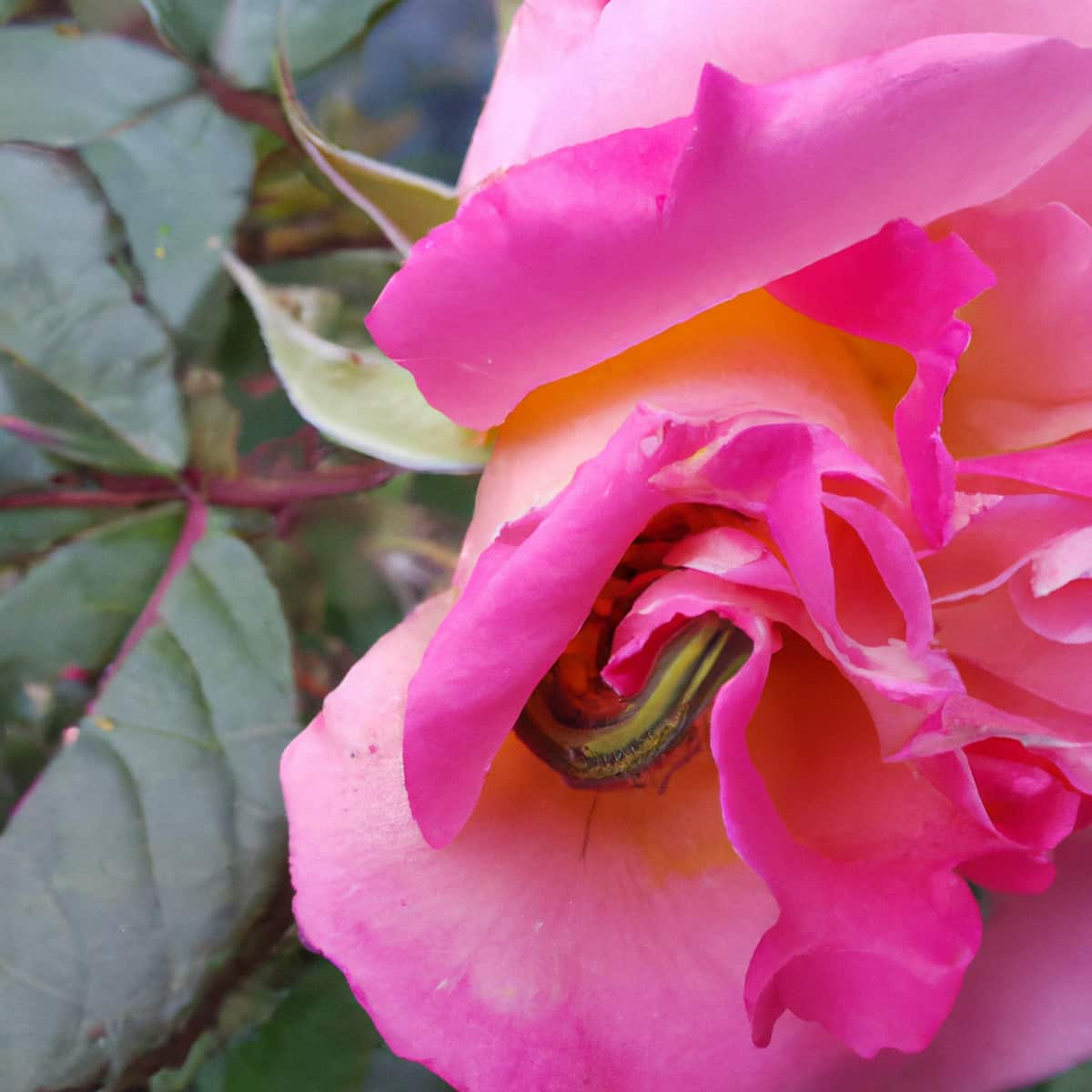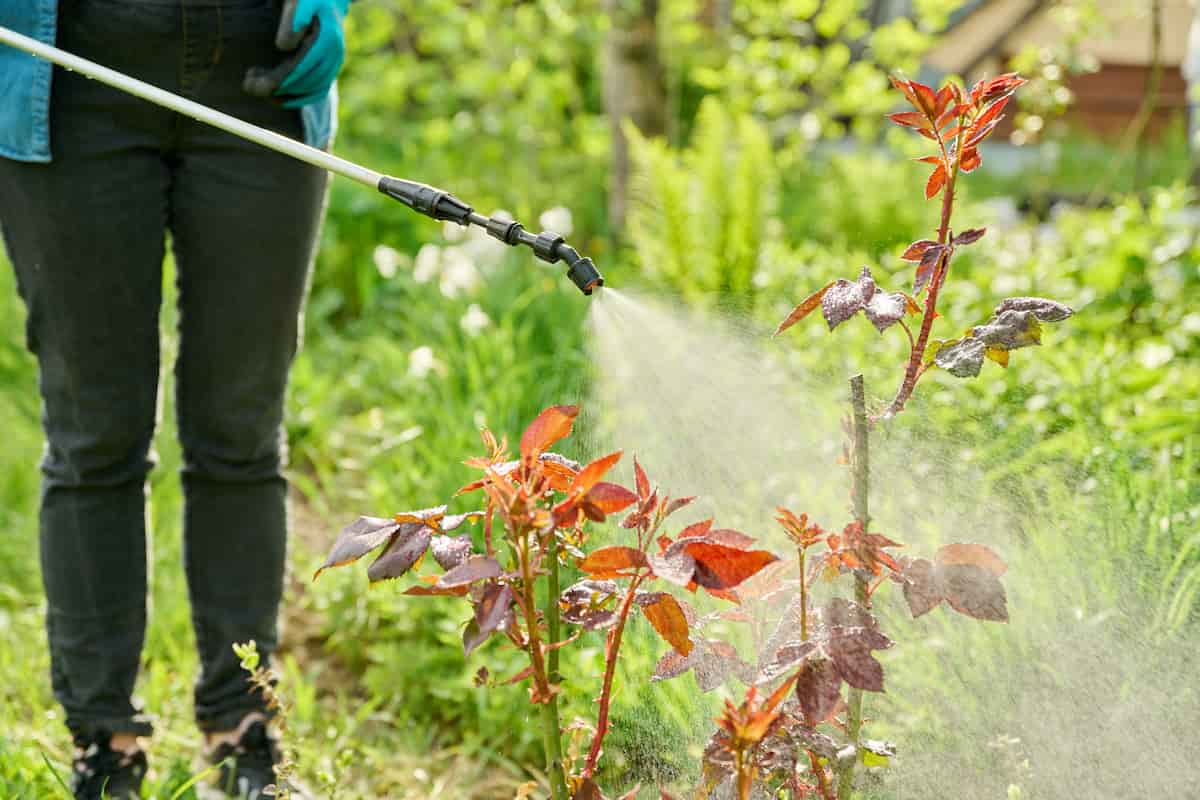The Rose Slug Caterpillar, Parasa lepida, belonging to the Family Limacodidae of the Order Lepidoptera, is a notorious insect pest that causes significant yield losses and reduces the quality of crops worldwide. This caterpillar pest is native to Asia. It is a destructive pest because it can reproduce and establish large populations quickly, making it difficult to control the pest.

Effective management strategies are essential to minimize the impact of this pest on Rose production. To effectively manage this pest, it is necessary to understand its life cycle, its preferred habitats, and the best methods for controlling it. This article will provide an overview and discussion of the Rose Slug Caterpillar Pest in Rose crops, including its symptoms, identification techniques, and control.
Slug Caterpillar Pest Management in Rose
Life Cycle of Rose Slug Caterpillar Pest in Rose Crop
The life cycle of the Rose Slug Caterpillar pest has four stages. They are egg, larva, pupa, and adult. The lifecycle of the Rose Slug Caterpillar begins when the female lays eggs in clusters on the underside of the leaves. The female moth can lay up to 200 eggs at a time. Once the eggs hatch, the larvae emerge and begin to feed on the foliage of the rose plants. They move like slugs and leave behind a slimy trail. As the larvae grow, they molt their skin several times, shedding their old skin and developing a new, larger one.
The larvae feed on the rose leaves for several weeks until they reach full size. After the feeding stage, the larvae will pupate, creating a cocoon in the soil or nearby plant debris. During this stage, they metamorphose into the adult stage, which is a moth. Once the metamorphosis is complete, the adult moths emerge from their cocoons and mate to lay eggs for the next generation. The entire lifecycle of the Rose Slug Caterpillar Pest can take several weeks to several months, depending on environmental conditions.
Occurrence of Rose Slug Caterpillar Pest in Rose Crop
- Location of Rose Slug Caterpillar Pest: This pest infests Rose crops in India, Africa, Sri Lanka, China, Thailand, Vietnam, Indonesia, the United States, Mexico, Brazil, Colombia, Ecuador, the Philippines, and Australia.
- Host Range: The Rose Slug Caterpillar pest infects crops like Rose, Mango, Guava, Citrus, Tea, Avocado, Litchi, and Cashew.
Factors Favoring the Population Increase of Rose Slug Caterpillar Pest in Rose Crop
- Temperature – The pest prefers warm and humid environments. It is most active during the monsoon season, which coincides with the blooming season of roses.
- High Humidity – High humidity levels above 80% can create favorable conditions for the pest to thrive. Rainfall or over-watering of plants can also contribute to it.
- Plant Age – The pest prefers to infest young plants and new growth.
- Pest Appearance – The pest can also thrive in areas with high populations of natural predators, such as birds, spiders, and wasps, as they avoid the pest due to its protective spiny appearance.
Identification of Rose Slug Caterpillar Pest in Rose Crop
- Egg: The eggs are small, round, and light green.
- Larva: The larvae are greyish-green with brown spots, 5cm long, and have numerous spines that protrude from their bodies.
- Adult: The adult has a wingspan of 6 cm and is brown or gray with distinct patterns on its wings.
In case you missed it: Blackspot Management in Rose: Symptoms, Treatment, Chemical, Biological, Natural, and Organic Control

Damage Symptoms of Rose Slug Caterpillar Pest in Rose Crop
- The characteristic symptom of this pest is it can defoliate entire plants in a short time, resulting in reduced flower quality.
- The pest prefers to infest young and tender plant parts, such as young leaves, buds, and flowers.
- The pest larvae are known to feed on the soft tissues of the leaves, causing characteristic damage to the foliage.
- The pest gets its name from the slug-like appearance of its larval stage, characterized by a lack of legs and a slimy body.
- The larvae leave a slimy trail behind them when they move.
Percentage of Yield Loss in Roses Due to Rose Slug Caterpillar Pest
- In India, the yield losses due to Rose Slug Caterpillar pests are 10-60%. In Thailand, the percentage of yield loss is 20-30%. In Vietnam, the losses are 25%. In Sri Lanka, the losses are 30-90%. In Indonesia, the losses are 30%. In Africa, it is 40%. In the United States, it is 5-10%. In Mexico, it is 20%. In Brazil, it is 30%. In China, it is 40%.
- In Colombia, the losses are 60%. In Ecuador, it is 40%. In Australia, it is 10%. In the Philippines, the yield losses are 50%. The Economic Threshold Level (ETL) for the Rose Slug Caterpillar pest is set at 10-15% crop infestation.
Cultural Control of Rose Slug Caterpillar Pest in Rose Crop
- Handpicking – Handpick the caterpillars and the infested leaves manually and destroy or drop them into a bucket of soapy water to kill them.
- Sanitation – Infested plant debris should be removed and destroyed, and the affected plant parts should be pruned immediately.
- Fertilization – Avoid over-fertilization, which can promote tender growth, which is more susceptible to pest infestation.
- Companion Planting – Planting crops like garlic, onion, and chives to repel or deter the pest.
Biological Control of Rose Slug Caterpillar Pest in Rose Crop
- Predators – Birds like black drongos, common mynas, and Spiders like orb-weaver and lynx spiders feed on the caterpillars.
- Parasitoids – Parasitic wasps such as Trichogramma chilonis and Bracon hebetor have been found to parasitize the eggs and larvae of the pest.
- Entomopathogenic Fungi – Entomopathogenic fungi, such as Beauveria bassiana and Metarhizium anisopliae, infect and kill the pest.
Chemical Control of Rose Slug Caterpillar Pest in Rose Crop
- Spray Insecticides on the crops like Carbaryl, Malathion, Cypermethrin, Permethrin, Deltamethrin, Methyl Demeton, Methyl Parathion, Imidacloprid, and Thiamethoxam on the foliage to control the pest.
- Fumigants – Treat the soil with Methyl Bromide to control the pest in the ground.
Organic Control of Rose Slug Caterpillar Pest in Rose Crop
- Diatomaceous earth damages the exoskeleton of insects, causing them to dehydrate and die.
- Pyrethrum, obtained from chrysanthemum, contains neurotoxins that paralyze and kill the pest.
- Bacillus thuringiensis-based bio-insecticides produce toxins that can kill the larvae of the pest.
- Spinosad produced by the soil bacterium Saccharopolyspora spinosa should be sprayed on the leaves and stems of the plants to control the pest.
Preventive Measures for Control of Rose Slug Caterpillar Pest in Rose Crop
- Resistant Varieties – Planting healthy, resistant, or tolerant varieties can prevent pest incidence.
- Regular Monitoring – Monitor the crops regularly to identify pest infestation in the early stages to keep it under control.
- Physical Barriers – Physical barriers like row covers, nettings, and screens can prevent the pest from accessing the rose plants.
- Sticky Traps – Use yellow sticky traps to monitor the pest’s activity and determine the control measures.
- Pheromone Traps – The use of pheromone traps can help capture adult pests and reduce the population.
In case you missed it: Rose Red Spider Mite Pest Management: Symptoms, Treatment, Chemical, Biological, and Organic Control

Conclusion
The Rose Slug Caterpillar Pest, Parasa lepida, is a serious pest that affects Rose crops worldwide, causing significant yield losses. Implementing IPM practices in rose crops can help mitigate the damage caused by the pest, contributing to improved productivity and quality of roses.
- Types of Fungicides Used in Agriculture
- Common Issues in the Fruit Development Stage of Pomegranate Farming
- Fruit Development Issues in Papaya: Easy Solutions and Treatment
- Soil-Borne Diseases and How to Protect Your Plants
- Practices to Prevent Disease Spread in the Garden
- From Wilted to Thriving: How to Treat Root Rot Naturally in Houseplants
- Natural Remedies to Cure Brown Spots on Fig Tree Leaves
- Natural Solutions for Poinsettia Problems: 100% Effective Remedies
- How to Control Calla Lily Problems: Natural Remedies for Leaf and Flower Problems